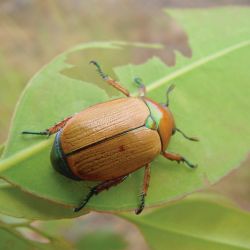Christmas beetle

Christmas beetle (Anoplognathus chloropyrus)
© NSW DPI

Christmas beetle (Anoplognathus porosus)
© NSW DPI

Christmas beetle (Anoplognathus boisduvali)
© Queensland Government

Christmas beetle damage to mature spotted gum leaves, showing characteristic jagged feeding pattern
©NSW DPI
Christmas beetles are significant pests of young eucalypt plantations and can cause severe leaf loss before canopy closure. Adult beetles emerge from the soil during the summer and feed on eucalypt foliage. Often several species are observed in plantations at the same time. They are hungry feeders and large swarms can defoliate trees rapidly.
Scientific name
Description
- Adult beetles are large, about 15-30mm long, yellow-brown to red-brown and shiny.
- Anoplognathus boisduvali has dark lines running down the wing covers and a red-brown hind section.
- A. chloropyrus has an iridescent, green hind section extending beyond the wing covers and faint black lines on the wing covers.
- A. porosus has black spots on the wing covers and no obvious coloured hind section.
Distribution
- Widely distributed throughout eastern and south-eastern Australia.
- Found in northern Queensland and south-eastern Queensland.
- More common in coastal, higher rainfall areas.
Hosts
- Spotted gum (Corymbia citriodora subsp. variegata; C. maculata)
- Dunn's white gum (Eucalyptus dunnii)
- Gympie messmate (E. cloeziana)
- Rose gum and hybrids (E. grandis)
- River red gum (E. camaldulensis)
- Forest red gum (E. tereticornis)
- Western white gum (E. argophloia) and Gympie messmate (E. cloeziana) are less commonly affected.
Damage
- Beetles feed in swarms, causing extensive damage to young plantations, especially if close to pastures.
- Feeding damage is visible as jagged, ripped patterns, typically on mature leaves. Beetles also feed on immature leaves.
- Young trees up to around 3 years old are most at risk.
- Tree form and growth can be inhibited with sustained or repeated infestations. In severe cases trees may die.
Biology
- Larvae live in soil, feeding on grass roots and decaying organic matter for around 12 months.
- Adults emerge from the soil in summer, often following rainfall, and fly to nearby host trees to feed on eucalypt leaves and to mate.
- Females return to the soil to lay eggs.
Control
- Native animals such as possums, currawongs, magpies and predatory wasps control Christmas beetles.
- Manage by planting less susceptible species, such as E. argophloia or E. cloeziana.
Resources and research
- Australian Museum, 2023. Christmas Beetle, viewed July 2023.
- Jones, DL, Elliot, WR, Jones, SR. 2015. Pests, Diseases, Ailments and Allies of Australian Plants. Reed New Holland Publishers Pty Ltd, Chatswood, NSW.